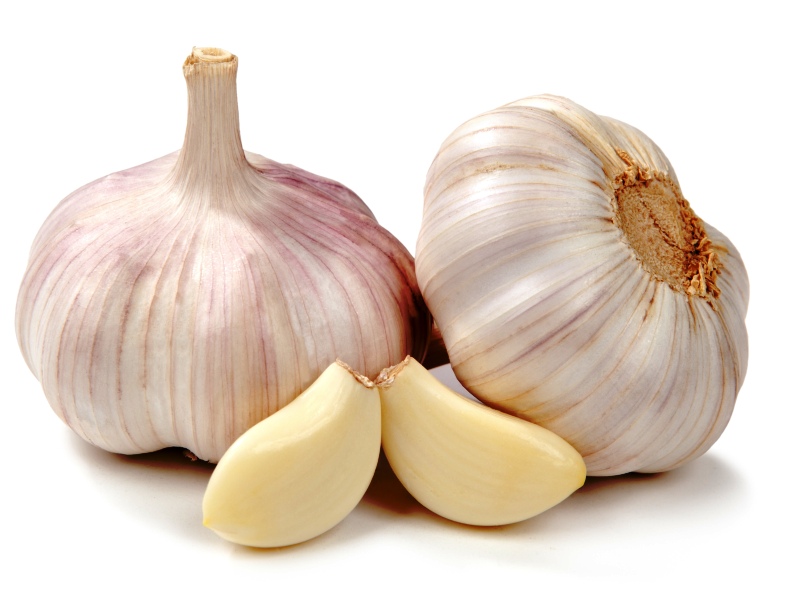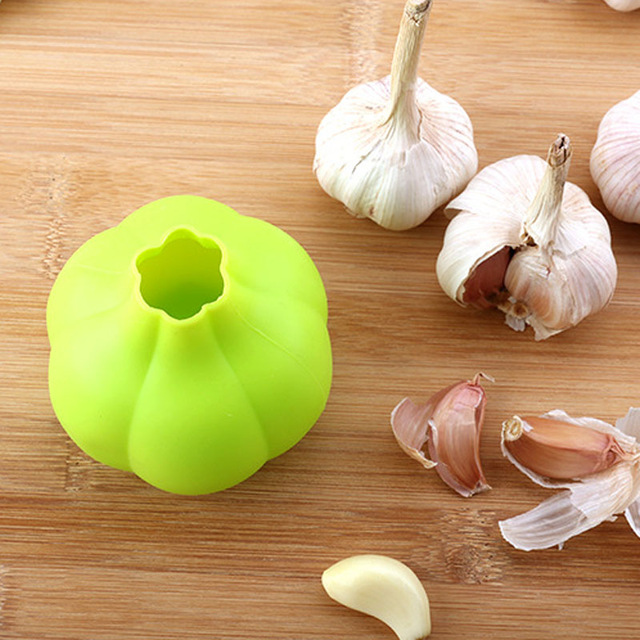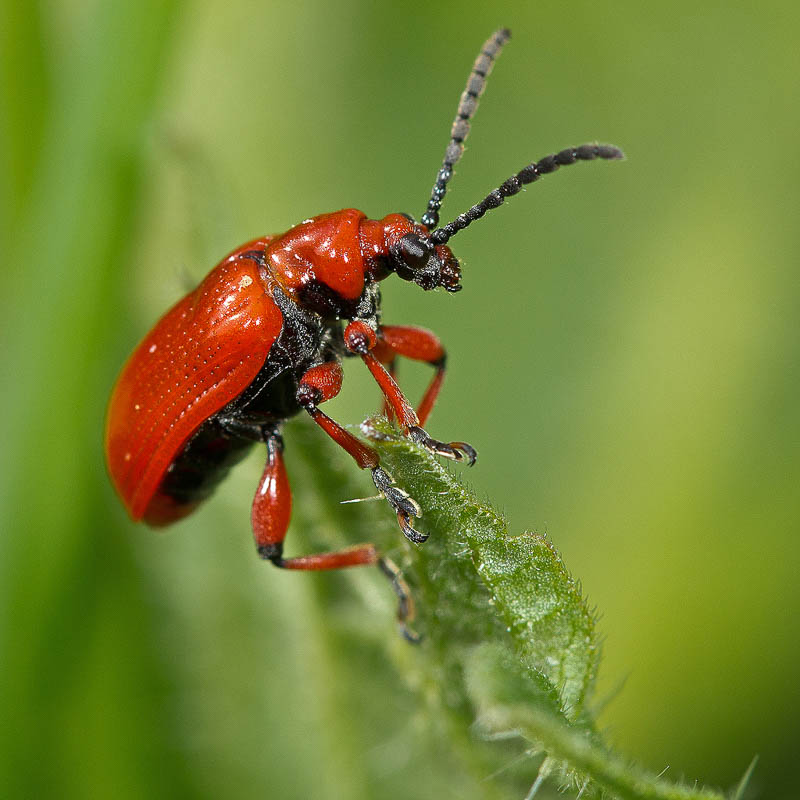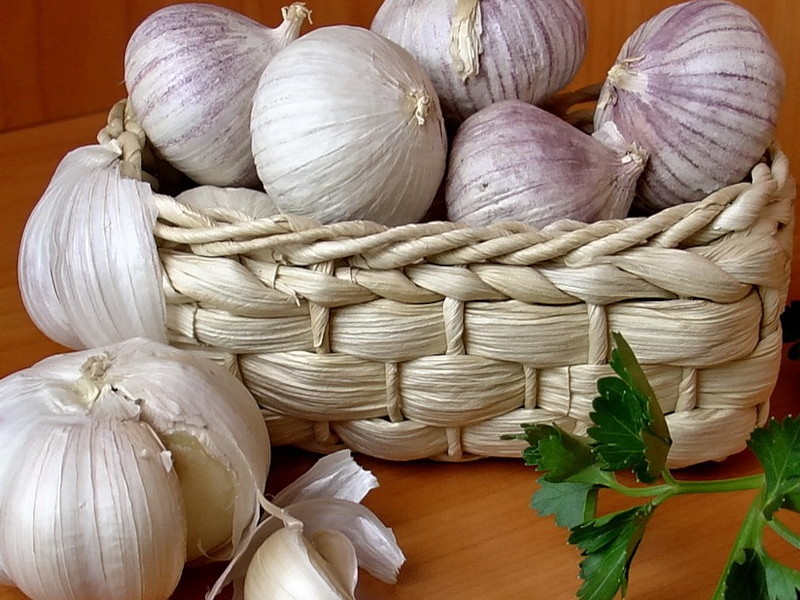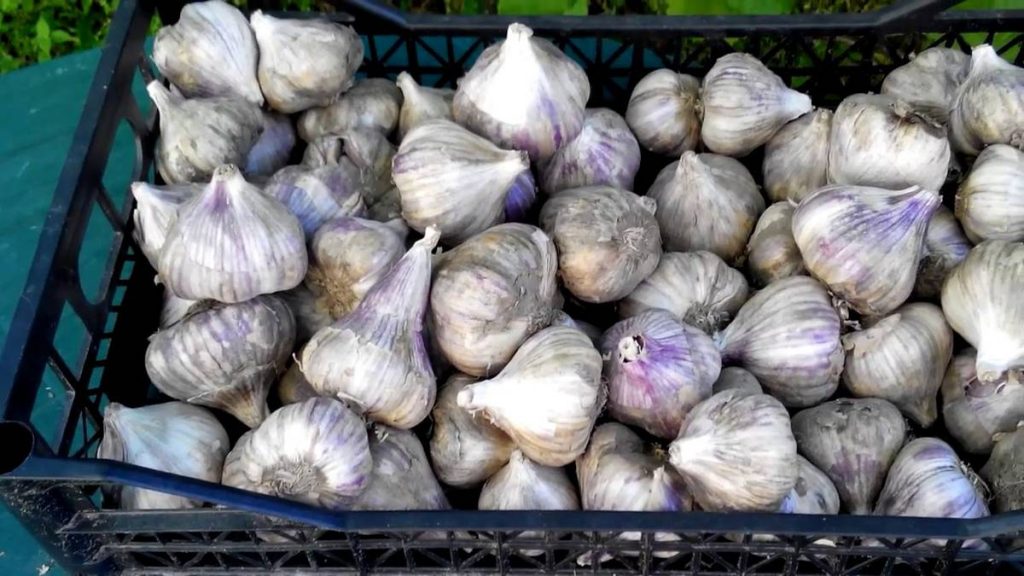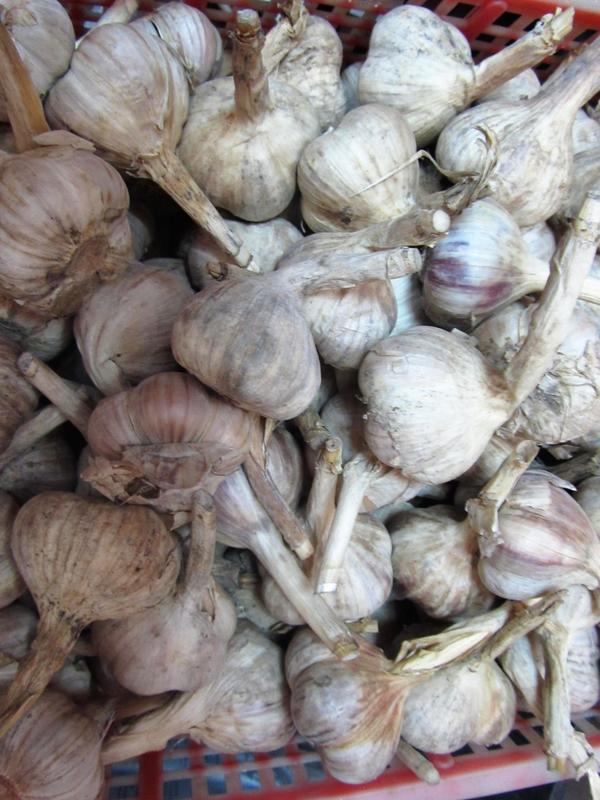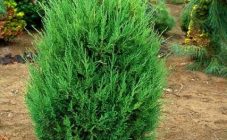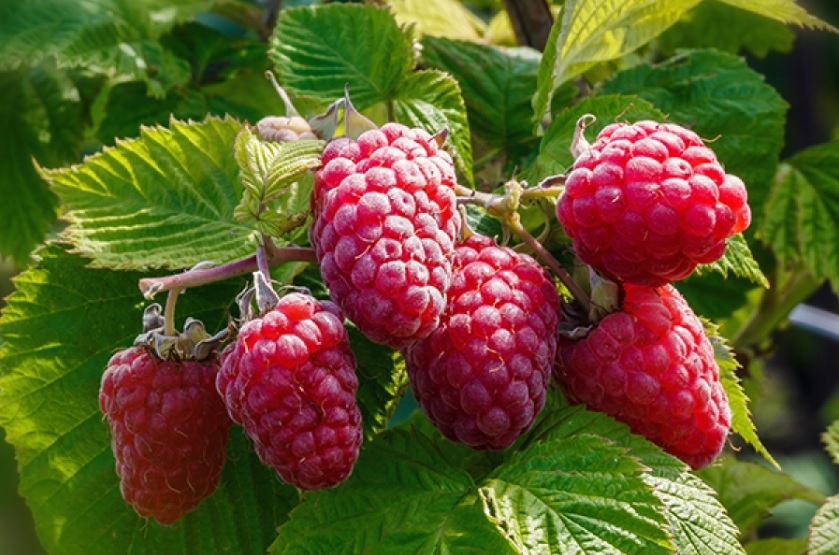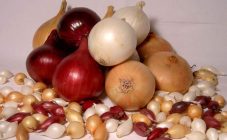Content:
Garlic is one of the first agricultural plants. It spread throughout the world from the foothill regions of Central Asia and took its place of honor in the cuisine of many countries. In our country, the vegetable is grown from the Urals, Moscow region to the Black Sea.
Garlic (Allium sativum) is a prominent representative of the Onion family of the Amaryllis family. A perennial culture, the basis of which is formed by the cuckoo (in most cases it is divided into cloves), a stem, a good root system.
In cooking, garlic cloves are used mainly fresh or dried as a condiment.
The composition of the vegetable is quite diverse:
- Carbohydrates (mono, - and disaccharides) - 83%;
- Protein - 16%;
- Fat - 1%;
- Vitamins - A, C, B6, B9;
- Macronutrients - potassium, magnesium, sodium, calcium;
- Trace elements - iodine, iron, manganese.
- Essential oils.
The calorie content of the product is 150 kcal per 100 g.
The effect of garlic on the human body:
- Contributes to the normalization of the cardiovascular system;
- Positive impact on atherosclerosis;
- Stabilization of blood pressure in hypertension;
- Antibacterial effect;
- Strengthening the immune system.
It is necessary to limit consumption in case of stomach diseases, allergies.
For a long time of growing garlic, a large number of sub-varieties have been developed, which are adapted to any climatic conditions, soil characteristics, and purpose.
Classification
Depending on the planting period:
- Winter variety. Planted in late autumn, before the first frost. With proper preparation and planting, winter garlic takes root well and can withstand 20 degrees of frost. You can harvest the crop in mid-July. Stores well in a dark, dry, cool place, practically until January. The main advantages of the winter variety are its resistance to diseases, unpretentious care. In addition, winter varieties attract with their appearance - large teeth of the correct shape;
- Spring garlic. You need to plant in the spring, preferably in April - the soil should warm up well.
A distinctive feature of the spring variety is a large number of cloves of different sizes. The main advantage is long storage. Subject to a stable temperature (up to 3 degrees Celsius and low humidity), garlic does not lose its quality until the beginning of next summer.
Winter garlic, in turn, is divided into two subspecies:
- Shooting. The species that forms the peduncle arrow. One-tooth is grown from the inflorescence. If the seeds are not needed, the false stems have to be broken off, otherwise you can lose a significant part of the crop;
- Non-Shotgun. They reproduce only by cloves. Do not need additional care.
Garlic is classified by application:
- Technical grade. Moderately spicy with a high oil content. Used mainly in the food industry;
- Table grade. Large teeth, sharp enough with a small percentage of oil. Designed for home use.
Garlic is also distinguished by its color: white, pink, purple with a blue tint.
Agrotechnics
The process of growing a crop is not too complicated, but it has its own characteristics.The main requirement is fertile soil. Sandy soils with neutral acidity are suitable for garlic. In addition, the plant loves light, warmth and does not tolerate waterlogging.
A special feature of garlic is the ability to grow it together with other vegetables, berries and even flowers. It protects different crops from diseases and pests. Beans, peas and cabbage do not tolerate the neighborhood with this plant. But it is recommended to plant garlic after these plants. It is possible to plant garlic at the site of growing onions after 4 seasons.
The culture propagates with the help of cloves. Arrowhead species can be grown from seeds - aerial bulbs. But this is a long and laborious process and is rarely used.
The future harvest largely depends on the quality and preparation of planting material.
The process of preparing the teeth consists of two stages:
- Calibration. Large, regular, undamaged teeth are selected;
- Disinfection. The seeds are kept in ash liquor (ash infusion - 0.5 l of ash per 2 l of water).
Growing garlic of spring varieties
Spring garlic is planted in April - early May. If necessary, moisten the soil, fertilize with ash, humus. Rows 5 cm deep are made with an interval of 20 cm. The cloves are planted at intervals of up to 10 cm. After planting, they are carefully sprinkled with soil and lightly tamped.
Watering is carried out as needed, not too abundant. You can fertilize garlic with ash 2 times per season: in spring after planting and at the end of June - July.
Maintenance includes regular soil loosening and mulching.
Growing garlic of winter varieties
Planting of winter garlic is carried out in October - early November, depending on weather conditions. The main secret of growing varietal winter garlic is timely planting. There is no need to rush to plant the teeth - due to the prolonged influence of high temperature, the seeds begin to germinate, and when frost sets in, the sprouts may be damaged. In this case, it is better to spend time.
The garden bed is dug up in advance. Grooves are made, 10-15 cm deep at a distance of 20-25 cm. Each row is lined with a ball of sand or ash. Garlic is planted with an interval of 8-10 cm. The planting process ends with mulching - the bed is covered with mulch (peat or sawdust).
If the climatic conditions are harsh, a film, roofing felt or another ball of mulch is additionally used.
If you want to dilute varietal garlic from onions - bulbs (from a flower-nose), seed material is sown to a shallow depth in autumn or spring. Cloves are collected in the summer. And already next year, an excellent harvest can be grown from these cloves.
Diseases and pests
Despite the resistance of garlic to most diseases, there are several diseases that affect this vegetable: bacterial, white and black rot, peronosporosis, fusarium.
Pests that pose a danger are onion flies and their larvae, hoverflies, moths, nematodes, and garlic mites.
The basis for preserving the crop from damage by pests and diseases is the selection of high-quality planting material, the timely removal of diseased plants and processing with special means.
The main types and varieties of garlic
The wide distribution of the plant, its popularity contributed to the breeding of many types of culture. The variety of varieties is striking: early, later, large, small, spicy and not so. The main forms of vegetables are also distinguished: garden, leek (onion and garlic), wild, ornamental.
Popular varieties of domestic selection
- The Lyubasha garlic variety is an excellent version of the winter species. The plant is quite tall, reaches a meter in height. The color of the fruit is light with a purple tint. Not whimsical in leaving. Quite spicy, keeping well;
- Dobrynya garlic is a late variety, the main property is large heads, light gray in color.Low - up to 70 cm. Moderately sharp, long shelf life, disease resistant;
- Sibirskiy variety is a mid-ripening winter variety. Gray surface with a violet tinge, medium-sized head. Differs in pronounced taste and increased frost resistance.
The varieties of the giant's garlic are well known;
- The Alekseevsky variety is a winter type of garlic, known as the Alekseevsky giant, is distinguished by its high yield and large bulb size. The weight of one head can reach 200 g. Plant height reaches 5 m in height. The taste of the giant is also special - sweetish spicy, with a delicate, unobtrusive aroma;
- Garlic Gulliver is a spring variety with large fruits (up to 150 g). Sharp enough, dark gray in color. A high-yielding variety with good keeping quality. Resistant to various temperatures and diseases;
- Garlic Komsomolets is a winter variety. It is characterized by large bulbs - up to 120 g. Mid-season, very spicy and aromatic.
Popular varieties of world selection
The most common in the world are Chinese, Russian, Uzbek, Vietnamese, Pakistani garlic. Varieties of garlic and ornamental garlic are quite popular. Some of the world's collections are worth discovering and seeing better.
Description of popular varieties of garden garlic:
- Southern purple local - Uzbek garlic. Winter arrow variety of late ripeness. Pungent taste, purple-violet scales, medium-sized heads. Differs in drought resistance;
- Flavor is a French garlic known for its exquisite taste and piquant aroma. Spring, mid-season variety. The shell is light pink. The heads are large, the teeth are small. Thermophilic, with a long shelf life;
- Casablanca is a high-yielding Dutch variety. Winter, large teeth, white shell color. Good keeping quality, resistance to diseases;
- Red duke (Red duke) - Czech variety. Winter, fruitful, resistant to different weather conditions. Bulbs are large, purple in color, of pronounced color and taste;
- Garlic from Lishon Island is a famous Vietnamese species. It gained its popularity by its snow-white color and lack of smell after consumption;
- Black is the original variety, a variety of Japanese garlic. This color appears as a result of fermentation. Regular garlic is exposed to high temperatures, as a result of which melanoidins are born - and they stain the cloves dark. Black garlic has a sweet taste, no garlic aroma;
- Chinese is a variety of garlic without cloves.
Peruvian and Chilean varieties are distinguished by their sharpness and aroma.
Types of garlic leeks (chives)
Among them, varieties with original names stand out:
- Rocambol (elephant, Egyptian garlic) - a hairstyle known for its gigantic size - reaches 500 g in weight. There are winter and early varieties of this species. Differs in garlic aroma and delicate taste. One of the favorite varieties in American cuisine;
- Leek Garlic Shallot is a type of onion with a slight garlic flavor. A feature of this variety is the presence of a nest with several bulbs. Their number can be up to 20;
- Altai wild garlic is a type of garlic onion, similar in taste and shape to wild garlic.
Decorative varieties of garlic conquered the hearts of gardeners in many countries with the variety and brightness of flowers. In this case, the fruits of the ornamental form of the plant are no different from ordinary garden garlic species.
The most popular representatives of this type are:
- Indian garlic is a winter type. It stands out for its beautiful purple color of the flower. Requires more careful maintenance;
- Variety Moli (Golden Garlic-Onion) - has an amazing golden color. Unpretentious to the soil, in care, can grow in a shaded place.
Garlic has long and thoroughly entered our life. We can no longer imagine our favorite dishes without the usual aroma.The main thing, if you want to grow a good harvest, is not to get lost among the variety of varieties and species, to find the most suitable one for your needs, tastes and capabilities.
